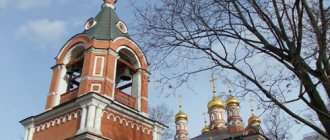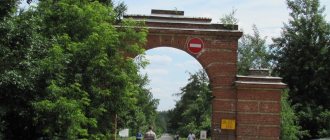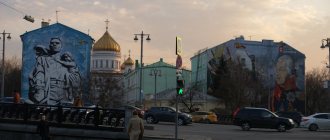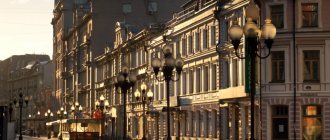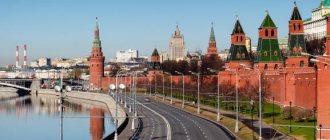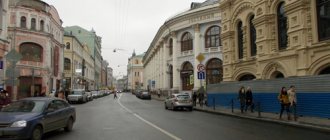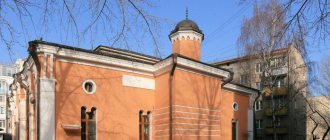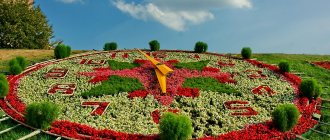Pyatnitskaya Street is located in the Zamoskvorechye district of the Central District of Moscow. It runs from the Chugunny Bridge across the Vodootvodny Canal to Serpukhovskaya Square, located on the Garden Ring.
The length of the street is 1815 meters.
The nearest metro stations are Novokuznetskaya and Tretyakovskaya.
History of Pyatnitskaya Street
The street arose at the turn of the 14th - 15th centuries as part of the road to Serpukhov, Tula and other cities located south of Moscow.
This territory became part of Moscow at the end of the 16th century after the construction of the fortifications of Zemlyanoy Gorod.
In the 16th - 17th centuries, settlements existed in this area, where traders, artisans, and archers lived.
Since the 16th century, the Paraskeva Pyatnitsa Church was known, which later gave its name to the street. In the 17th century, a stone building was built for it, and in the 18th century a new temple was erected on this site.
In the 18th - 19th centuries, Pyatnitskaya Street, like Zamoskvorechye in general, was a place where mainly merchants lived. At this time, stone buildings appeared here.
In the 1850s, L.N. lived in one of the houses. Tolstoy. Nowadays a museum is opened here.
At the end of the 19th - beginning of the 20th centuries, at the end of the street, in specially built buildings, there was a printing house of the famous publisher I.D. Sytin. Nowadays, a printing house is also located here.
In 1934, the Paraskeva Pyatnitsa Church was demolished, and in 1943, the lobby of the Novokuznetskaya metro station was built on this site.
Some buildings located on Pyatnitskaya Street were rebuilt during Soviet times, but for the most part the street retained its architectural appearance.
Among the attractions of the street are the churches of Clement, built in the 18th century, and the Trinity Church in Vishnyaki, built at the beginning of the 19th century. In addition, many houses built from the 18th to early 20th centuries have been preserved.
LiveInternetLiveInternet
Pyatnitskaya street
One of the main streets of Zamoskvorechye is the ancient Pyatnitskaya Street, which runs between Serpukhovskaya (Dobryninskaya) Square, the Cast Iron Bridge over the Obvodnoy (Vodootvodny) Canal and Kadashevskaya Embankment. Here is one of the rare cases in modern Moscow, one of the few exceptions: the street has retained its historical name, and has not lost it in the turbulent era of revolutionary events and “socialist construction.”
Pyatnitskaya is not just one of the oldest streets in Zamoskvorechye. She became a symbol of this patriarchal part of Moscow, where even in the “faces” of many houses the world of heroes and characters from A. N. Ostrovsky’s plays was preserved. I think it was the spirit of antiquity that brought to life one of Bulat Okudzhava’s songs:
| How I like driving along Pyatnitskaya in a car! I cannot contain my admiration for what I saw. Its houses float like ships from the past, as if it’s not a street—it’s history itself... |
I’ll start the story about the history of Pyatnitskaya Street and its name with the word street
.
In its origin it is very ancient - common Slavic. Experts in the etymology of words and historical grammar note that street is
a suffixal derivative of
ul
lane
,
alley
, and the dialect word
ulka
also arose .
I think you will be surprised if you find out that the root in the word street
is the same as in the Russian words
snail
(originally - having a beehive, hollow, empty),
hive
(originally - a hollow tube, hollow), in Greek
aulos
(cavity), Westphalian
aul
(meadow, depression) and others.
In other words, the street
literally meant “empty”, “freed from thickets”.
The closest relatives of this word are in most Slavic languages: in Ukrainian - vulitsa
, Belarusian -
vulitsa
, Bulgarian -
street
, Serbo-Croatian -
blitz
, Slovenian -
ulica,
Czech -
ulice
, Polish -
ulica
.
In the Old Russian language, the concept of street
meant “passage”, “passage” (the oldest example of this is found in the “Tale of Bygone Years” under the year 6582, according to modern chronology - 1074), “street”, “passage between rows of houses”, “gate " and even "square".
For example, the noun ulichnik
with the meaning “gatekeeper”.
Well, in ancient Novgorod, the word street
also called a section, a part of the city. Scientists believe that the oldest meaning of this word among the Slavs was “passage (in general)”, from where it later appeared what has come down to our times - “a space open for passage and passage between two rows of houses in a populated area.”
Like many other ancient thoroughfares, central ray-streets, often later developing into avenues, Pyatnitskaya Street also arose originally from a road
. This was one of the few old Moscow roads to the south - to Ryazan, Tula, Serpukhov, and other cities. It was laid in Zamoskvorechye at a time when this area was still covered with forests that reached the banks of the Moscow River.
Pyatnitskaya is one of the most interesting and oldest streets in modern Moscow and Zamoskvorechye. Despite the relative narrowness of the roadway and one-way traffic, it remains an important transport route in the historical, reserved part of Moscow. Originally a large and busy shopping road, Pyatnitskaya later turned into a shopping street. It is noteworthy that the street has retained this feature of its socio-economic function for many centuries and has carried it to the present day. This can be judged, for example, from old guidebooks. One of them, the famous book “Around Moscow: Walks around Moscow and its artistic and educational institutions,” edited by N. A. Geinike and others, was published at the beginning of the 20th century. Here are the characteristic epithets used by its compilers in relation to Pyatnitskaya Street: “Pyatnitskaya is a lively, noisy, somewhat dirty trade artery of Zamoskvorechye.” Walk along Pyatnitskaya today with its abundance of shops and benches - you will be convinced that the commercial character of this street was preserved until the very end of the twentieth century.
And a little more about the history of that part of Moscow, which since ancient times has been called Zamoskvorechye
. Let’s open the book by Yu. A. Fedosyuk “Moscow in the Garden Ring”:
“This low-lying area across the river was often flooded with flood flows. From the south, hordes of nomads rushed along it towards the Kremlin, destroying everything in their path with fire and sword. But Zamoskvorechye was persistently populated and built up, as if in spite of both water and fire.”
Of course, rich people found more reliable places to live, but here at first dependent people, slaves and stinkers lived in smoke huts and shacks. However, with the strengthening of the centralized Russian state, Zamoskvorechye began to be built up more and more thoroughly. In addition to the impoverished peasants, traders and artisans began to settle there: they were attracted by the proximity of the busy trade road to Serpukhov and Tula.
The authority of Zamoskvorechye was especially strengthened after Ivan the Terrible settled the Streltsy army there - a reliable stronghold and shield of the Moscow state. Around the Streltsy households with their sturdy huts and large vegetable gardens, craft settlements expanded - kadashes (coopers), blacksmiths, tanners, trade with the south was brisk, especially after the fall of the Golden Horde. Strong stone churches appeared, one of them received the name of Paraskeva Pyatnitsa, hence the name Pyatnitskaya Street.
The son of Ivan the Terrible, Fyodor, in 1591 ordered to surround Moscow with a 14-verst earthen rampart; Finally, Zamoskvorechye received cover from the invasions of foreign enemies.
In the 17th century, after the liberation war with the Polish-Swedish invaders, which directly affected Zamoskvorechye, the role and influence of local artisans, traders, and peasants in the affairs of Moscow and the entire state increased noticeably. They take an active part in spontaneous uprisings (Copper and Salt riots).
In the 18th century, the merchants came to the first place in Zamoskvorechye, building here rich courtyards, barns, storehouses, and then factories. The serving nobility does not shy away from this populated area, decorating it with their magnificent chambers and beautiful mansions. Almost all of the lordly estates passed into the hands of merchants in the next century. Many features of the life of the Moscow merchants are known to us from the works of playwright A. N. Ostrovsky.
Orthodox churches became a sign of a particular Moscow area, its important distinguishing feature. It is quite natural that the streets and alleys in these places received their names from churches. Pyatnitskaya Street arose
. However, let us immediately clarify: the main altar of the church was consecrated in the name of the Holy Trinity, and in honor of St. Great Martyr Paraskeva Pyatnitsa is only a chapel of this temple. Despite this, the street was named Pyatnitskaya. Examples of this kind, associated with the special veneration of saints, in whose honor chapels in Orthodox churches were consecrated, are known in the toponymy of various Russian cities, and Moscow toponymy in particular. Pyatnitskaya street, named after the limit of St. Paraskeva Pyatnitsa is no exception.
For example, the famous Moscow street Yakimanka
, was also named after the chapel of the temple - in honor of the righteous
Joachim
and
Anna
at the Church of the Annunciation: two names merged in oral speech into one and turned into the word
Yakimanka
. Joachim and Anna are the father and mother of the Blessed Virgin Mary.
The Pyatnitskaya Church (chapel), after which Pyatnitskaya Street was named, does not exist now. This building stood where the ground entrance hall of the Novokuznetskaya metro station is now located. As I already said, only the chapel of the Church of St. was called Pyatnitsky. Trinity, more often referred to in Pyatnitskaya’s speech. From time immemorial, the church enjoyed special respect among Muscovites, since it housed the miraculous “revealed” icon. Initially, the temple was wooden; it was mentioned in the chronicle back in 1564 in connection with the news of the fire of Moscow. According to the “construction” books, in 1657 the Church of Paraskeva Pyatnitsa was already made of stone. In 1739, with donations from wealthy parishioners, merchants Gavrila and Roman Zhuravlev, construction of a new stone church began, which was successfully completed three years later. The Church of Paraskeva Pyatnitsa became an outstanding work of Russian architecture of the mid-18th century.
It had an amazing carving, a wooden iconostasis known throughout Moscow. In the “New Guide to Moscow” of 1833, the following lines were written about this church: “And it is impossible to enter this temple without feeling the awe inspired not only by the holy place, but also by the majesty of the architecture and the internal splendor of the temple.” Only a hundred years have passed... Cruel times have come in Russia. In 1934, by decision of the city authorities, the Temple of Paraskeva Pyatnitsa was destroyed - during the fight against the Orthodox faith and in accordance with the new General Plan of Moscow and the ideas, never realized, of the continuation of the Boulevard Ring through the territory of Zamoskvorechye. Ten years later, in 1944, the lobby of the Novokuznetskaya metro station was erected on the resulting wasteland.
The fact that even in the capital old Moscow toponyms in the minds of modern residents are increasingly losing their “transparency”, losing touch with the true motives of their origin, unfortunately, is both obvious and quite well known. Nevertheless, the results of a blitz survey of 95 residents of Zamoskvorechye are still striking (the sample was, of course, random, including according to social parameters and age). Only 8 people named the correct etymology of the toponym Pyatnitskaya
street - “by the church of St.
Great Martyr Paraskeva Pyatnitsa”, “according to the Pyatnitskaya Church”. Three were able to say something about Paraskeva Pyatnitsa. Twenty-four of the respondents more or less confidently associated the toponym with the common noun Friday
(“fifth day of the week”).
I’ll immediately note that the derivative from Friday
(“day of the week”) is
Friday
, and not
Pyatnitsky
, which only two people noticed during the survey.
Twenty-six people, when asked about the origin and motivation of the toponym, suggested that the name of the street was of a memorial nature: “Given in honor of a man named Pyatnitsky.” It is characteristic that as a possible owner of the surname, whose memory could be immortalized in this way, more than half of these 26 people confidently named the famous collector of Russian folk songs and the founder in 1910 of the Russian Folk Choir, which has been bearing his name since 1927 - Mitrofan Pyatnitsky. It is also interesting that one of the respondents no less confidently named the famous revolutionary Joseph Pyatnitsky, repressed by Stalin. Two more people associated the toponym Pyatnitskaya Street
with the famous Pyatnitsky cemetery in Moscow, although one of them knew that the Pyatnitsky cemetery is located at the opposite end of Moscow, near the Rizhsky station and Rizhskaya Square, the former Krestovskaya outpost. It is characteristic that the Pyatnitskoye cemetery was named exactly the same as Pyatnitskaya Street - after the aisle of St. Paraskeva Friday Church of St. Trinity, built near the Krestovskaya outpost at the end of the 18th century. It was during that period, in 1771, during the plague epidemic, that the cemetery, now known as Pyatnitskoye, was founded. It has nothing to do with the origin of the name Pyatnitskaya Street.
Saint Paraskeva Friday was revered in Orthodox Rus'. In particular, she patronized travelers, and therefore temples in her honor or small chapels were often built near large and important roads. It is believed that the very image of Paraskeva Pyatnitsa is rooted in the image of the deity Mokosh, widespread among the Eastern Slavs in ancient times - the patroness of cattle breeding, the goddess of winds and water, women's farming and marriage (Mokosh was an epithet of Lada). Friday is also a particularly revered day among Christians. Here is what is written about this in the two-volume “Complete Orthodox Theological Encyclopedic Dictionary”: “Friday has been revered since the first centuries of Christianity as the day of the suffering of the Lord Jesus Christ on the cross. ...Celebration and fasting on Friday are very deeply rooted among the people. ...The people personify Friday in the form of St. Martyr Paraskeva (in Greek “Friday”), considers her a special saint, whose memory is celebrated together with St. Paraskeva. Friday, or St. Paraskeva oversees the celebration of her day and severely punishes apostates; they turn to her with prayer for the girl’s groom; it also has an impact on the fertility of the land. The remnants of folk pagan beliefs were felt here.”
The Orthodox Church celebrates the memory of the Great Martyr Paraskeva Pyatnitsa, who lived in the 3rd century, in late autumn - October 28 according to the old style (November 10 according to the new style). Surely you have heard a lot about the folk calendar. So, Paraskeva (or Praskovea) Friday was very often called a dirty woman
and
powder
- due to the weather conditions at this time of year: “...On Paraskeva Friday there is a lot of mud. ...Paraskeva Friday - four weeks until winter. ... There are seven weathers outside - it sows, it blows, it swirls, it stirs, it roars, it pours from above, it sweeps from below.” This is what it is, Paraskeva Friday, according to the signs of the Russian folk calendar. However, these ideas of our ancestors, already very far from religious realities, are hardly familiar to today’s Muscovites, even those living on Pyatnitskaya Street. And is it only for Muscovites? With these ideas, interesting, figurative Russian expressions and sayings also disappear.
From Church Slavonic Paraskev
The once widespread folk form of this female name in Russia also arose -
Praskovya
.
In fact, this name is actually Greek in origin; the word paraskeue
meant “preparation, preparation, eve of a holiday, Friday.”
There is no mistake here - it is “eve”, since Saturday was a holiday for the ancient Jews. Peculiar analogues of the Russian Praskovya
were the Bulgarian name
Petka
(“Friday”) and the Latin
Venus
, since the day of the week Friday was dedicated to the planet Venus among many nations.
It is clear that the dictionary says Friday
contains the root
five
, since Friday is the fifth day of the week, there is nothing unexpected here.
But did you know that the words five
and
punch
(drink) are close relatives?
The fact is that some words in unrelated Indo-European languages actually go back to the same ancient source, for example: mother, brother, fire
and others.
This also applies to some numerals, in particular the word five.
So, the word
punch
was borrowed by the Russian language in the 18th century from the English language, which, in turn, for its word
punsh
took a word from the Hindi language -
panca,
meaning “five”. It turns out that the drink was named after the number of components from which it was prepared. There were five such components: rum, lemon, sugar, spices and water.
Another interesting linguistic story is related to the famous Russian expression seven Fridays in a week
.
This humorous phraseological unit is usually used when they want to say about someone that he often changes his decisions and opinions. The writer Vladimir Muravyov in his book “Moscow Literary Legends Were” claims that the expression seven Fridays a week
appeared thanks to Moscow officials: “All contemporaries testify that the Moscow bureaucratic institutions of the 19th century, unlike those in St. Petersburg, retained patriarchal features; they were not dominated by laws and rules, but the will of the authorities and custom. So, as usual, Moscow officials worked absentmindedly on Friday, busy thinking not about business, but about the upcoming days of rest. Friday was their favorite day of the week. ...One can imagine what the attitude of officials was towards the petitioners on Friday and what the price was for the promises made only to get rid of the annoying visitor. These promises were forgotten immediately, and when the petitioner applied again, the official’s decision, naturally, had nothing in common with the previous one. The petitioners knew this very well. This is what the saying proves.”
A different opinion and, in my opinion, more correct, is held by professional linguists - the authors of the reference book “Experience in an etymological dictionary of Russian phraseology.” They believe that the expression seven Fridays in a week arose and came into use around the 18th century and is associated with the custom of concluding deals on Fridays: “On Friday, which was a free day from work, on market day, all sorts of transactions were arranged (primarily trade) , they usually concluded in the presence of witnesses hired for a fee. If it was necessary to terminate the contract, register its fulfillment, etc., then this was done again in the presence of the same witnesses. Witnesses, wanting to benefit, often rushed things without waiting for Friday.”
Let's return to the history of Pyatnitskaya Street. One of its characteristic features was that along with the merchants, archers also settled here. In the area of modern Pyatnitskaya Street in the 17th century, the Streletsky order of Colonel Matvey Vishnyakov
.
Vishnyakovsky Lane
facing Pyatnitskaya and the Church of the Holy Trinity in Vishnyaki.
Monetchikovsky lanes
remind us of the settlement of coin masters .
At the corner of Pyatnitskaya Street and Klimentovsky Lane
there is one of the best monuments of the Moscow Baroque - the magnificent 18th century Church of St. Clement, Pope of Rome.
Names of three Tolmachevsky lanes
(Bolshoy, Maly and Old, which connects Pyatnitskaya with Bolshaya Tatarskaya Street) are reminiscent of the settlement of the royal interpreters - Tolmatskaya (Tolmachevskaya).
The churches located here were called that way - St. Nikita the Martyr in old Tolmachi and St. Nikola "in Tolmachi". In Russia, interpreters were not just translators, but specialists in interpretation
. About the translators, Grigory Kotoshikhin, clerk of the Ambassadorial Prikaz of the 17th century, who fled to Lithuania and Sweden in 1664 and, by order of the Swedish government, wrote an essay on Russia, wrote that they translated old letters and books as a test, worked “sitting in the Prikaz, but they are not allowed to transfer great things to the courtyards themselves, because they are afraid of all sorts of destruction from fire time and other reasons.” About interpreters, Kotoshikhin wrote that their salary is less than that of translators, and that they are on duty in the Ambassadorial Prikaz, “they go about business and send all sorts of parcels, but they, like the ambassadors of neighboring states in Moscow, are assigned for interpreters."
It was on Pyatnitskaya, at the junction with Valovaya Street, that the printing house of the famous Russian book publisher I. D. Sytin, now the famous First Exemplary Printing House, was built at the very beginning of the 20th century. Pyatnitskaya Street is also connected with the revolutionary events of 1905 and 1917. And among some current Muscovites the toponym Pyatnitskaya Street
is associated with the concept of “radio”, because in the building near the exit from the Novokuznetskaya metro station, where the Pyatnitskaya Church once stood, the former USSR State Committee for Television and Radio Broadcasting was located and radio stations “Moscow”, “Yunost” and some others.
Pyatnitskaya Street begins from the Vodootvodny Canal, or more precisely, from the Chugunny Bridge across this canal. Mikhail Lermontov, in one of the versions of his early poem “Sashka,” writes that his hero lives in Zamoskvorechye, at the beginning of Pyatnitskaya Street:
| Once upon a time, beyond the Moscow River, on Pyatnitskaya, right next to the canal, Overgrown with worthless grass... |
The drainage canal was laid in 1783-1786 along the central bend of the Moscow River. It begins a little above the Bolshoi Kamenny Bridge and again merges with the river in the area of Shlyuzovaya Embankment. In 1783, a stormy flood and ice drift damaged the supports of the Bolshoi Kamenny Bridge, which had previously suffered a lot from the spring “revelations” of nature and the river. In order to inspect and repair this most important bridge in the capital, it was necessary to divert water from the main channel of the Moscow River. It was for this purpose that a special canal was built, which fully justified its name - Vodootvodny
and reaching a length of four kilometers (in the last century, Muscovites also called it differently -
Kanava
).
The canal route passed through low-lying, marshy areas that were once an old river. The features of the area were also reflected in Moscow toponymy; some of the names characterizing the local marshy places have survived to this day. This is Balchug Street; her name is based on the Turkic, Tatar word balchek, balchekh
, translated into Russian as “dirt”, “clay”.
Balchug is one of the oldest Moscow streets, which arose at the end of the 14th century in the Balchug
. Before the construction of the Vodootvodny Canal in this part of Moscow, the soil did not dry out for a long time after the floods. The Moscow Balchug had a direct “relative” in Nizhny Novgorod in the area of the Nizhnevolzhskaya embankment; over time it disappeared due to the development of the city.
In this place of old Moscow there was also the Boloto tract. In ancient times, this part of the floodplain of the low bank of the Moscow River was a very damp, wet place - a real swamp, which was associated with both the low level of the bank and frequent floods after heavy rains and spring floods. Tract Swamp
known in Moscow since the Middle Ages.
Babi Gorodok
tract, was built in 1836 between the current Bersenevskaya and Kropotkinskaya (Prechistenskaya) embankments , the Vodootvodny Canal became navigable. Subsequently, its banks were reinforced with concrete walls and lined with granite, and this is how the Yakimanskaya, Kadashevskaya, Ovchinnikovskaya, Shlyuzovaya, Bolotnaya and Sadovnicheskaya embankments arose.
The cast iron bridge spans the Vodootvodny Canal. It connects Pyatnitskaya Street with Balchug Street. The motivation for its name is simple. The bridge was built in 1889 on the site of an old wooden one built back in 1835. Although that first bridge was made of wood, it had cast iron railings, which is why it got its name - Cast Iron
. The new bridge inherited his name. Nowadays, the spans of the Cast Iron Bridge are made of reinforced concrete.

